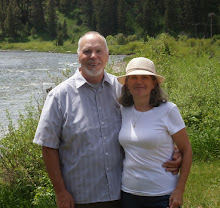We are staying at Walter Johnson Park, which has campsites with water and electric. Most of the others here are also working at Amazon.com for the season. Since the park is on the edge of town everything is close by. The park is named for a former Washington Senators pitcher and one of the first inductees into the Baseball Hall of Fame. He lived in Coffeyville during the off season. He played in the Major League between 1907 and 1927 and set many pitching records, some of which remained unbroken for more than 50 years. Besides the campground there is a playground, picnic area, horseshoe pits, baseball fields and buildings used during the fair.
 As you can see from this picture taken in the park, they had a major flood here last year. When the local refinery shut down for the flood, a valve was left open and 90,000 gallons of oil were spilled into the flood waters. The oil company had to purchase almost 400 homes that were damaged and tear them down.
As you can see from this picture taken in the park, they had a major flood here last year. When the local refinery shut down for the flood, a valve was left open and 90,000 gallons of oil were spilled into the flood waters. The oil company had to purchase almost 400 homes that were damaged and tear them down.





















